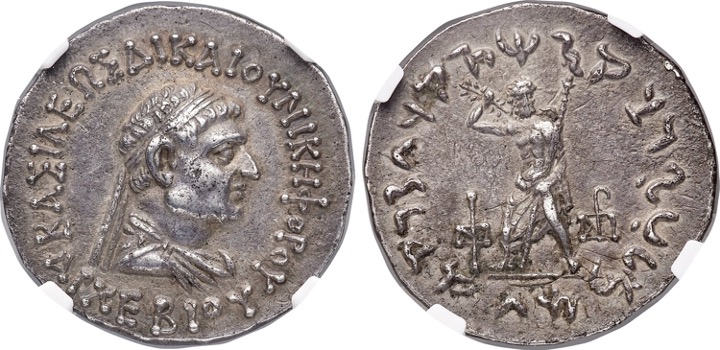75 BCE - 65 BCEΒΑΣΙΛΕΩΣ ΔΙΚΑΙΟΥ ΝΙΚΗΦΟΡΟΥ ΑΡΧΕΒΙΟΥ | Maharajasa dhramikasa jayadharasa Arkhebiyasa (of Great king Archebius the Just Victory-bearer)
Overstriking coin
SO_2105_-_Gandhara-Punjab_(uncertain_mint)_(Archebius).jpg
|
|
Sale(s)Sale(s) ᵖ:
|
Heritage World Coin Auctions, NYINC Signature Sale 3061, 07 Jan. 2018, 29287
|
|
|
|
Description
| ObverseInscription or printing placed on the obverse.:
|
ΒΑΣΙΛΕΩΣ ΔΙΚΑΙΟΥ ΝΙΚΗΦΟΡΟΥ ΑΡΧΕΒΙΟΥ (Greek) Bust of Archebius right, wearing diadem.
|
ReverseInscription or printing placed on the reverse.:
|
Maharajasa dhramikasa jayadharasa Arkhebiyasa (of Great king Archebius the Just Victory-bearer) (Kharoshthi) Zeus-Mithra standing facing, brandishing thunderbolt and holding long scepter. In left field, monogram.
|
Mint and issuing power
Chronology
| FromIdentifies the initial date in a range assigned in a numismatic context. 75 BCE toIdentifies the final date in a range assigned in a numismatic context.. 65 BCE
|
Hellenistic 323-30 BC  periodTime period of the numismatic object. periodTime period of the numismatic object.
|
Physical description
MetalThe physical material (usually metal) from which an object is made.: Silver 
|
WeightWeight of the numismatic object (in grams). in grams: 9.519.51 g <br />9,510 mg <br />
|
DenominationTerm indicating the value of a numismatic object. Examples: tetradrachm, chalkous, denarius.: tetradrachm 
|
AxisDescribes the directional relationship between the obverse and reverse of a numismatic object.: 11 mm <br />0.1 cm <br />
|
| DiameterDescribes diameter of an object (in mm).: 2828 mm <br />2.8 cm <br />
|
StandardStandard.: Indian
|
References
Description
| ObverseInscription or printing placed on the obverse.:
|
|
ReverseInscription or printing placed on the reverse.:
|
|
Mint and issuing power
| MintIdentifies the place of manufacture or issue of a numismatic object. ᵖ:
|
|
Ancient regionAncient region. ᵖ
|
|
Modern countryModern country:
|
AuthorityIdentifies the authority in whose name (explicitly or implicitly) a numismatic object was issued. ᵖ:
|
|
Chronology
| FromIdentifies the initial date in a range assigned in a numismatic context. toIdentifies the final date in a range assigned in a numismatic context..
|
periodTime period of the numismatic object.
|
Physical description
References
References
- ^ Mitchiner, Michael (1975), Indo-Greek and Indo-Scythian coinage, London,
- ^ Bopearachchi, Osmund (1991), Monnaies gréco-bactriennes et indo-grecques : catalogue raissoné, Paris, 459 p., 69 pl.
- ^ Hoover, Oliver D. (2013), Handbook of coins of Baktria and ancient India : including Sogdiana, Margiana, Areia, and the Indo-Greek, Indo-Skythian, and native Indian states south of the Hindu Kush, fifth century BC to first century, Lancaster-London,
